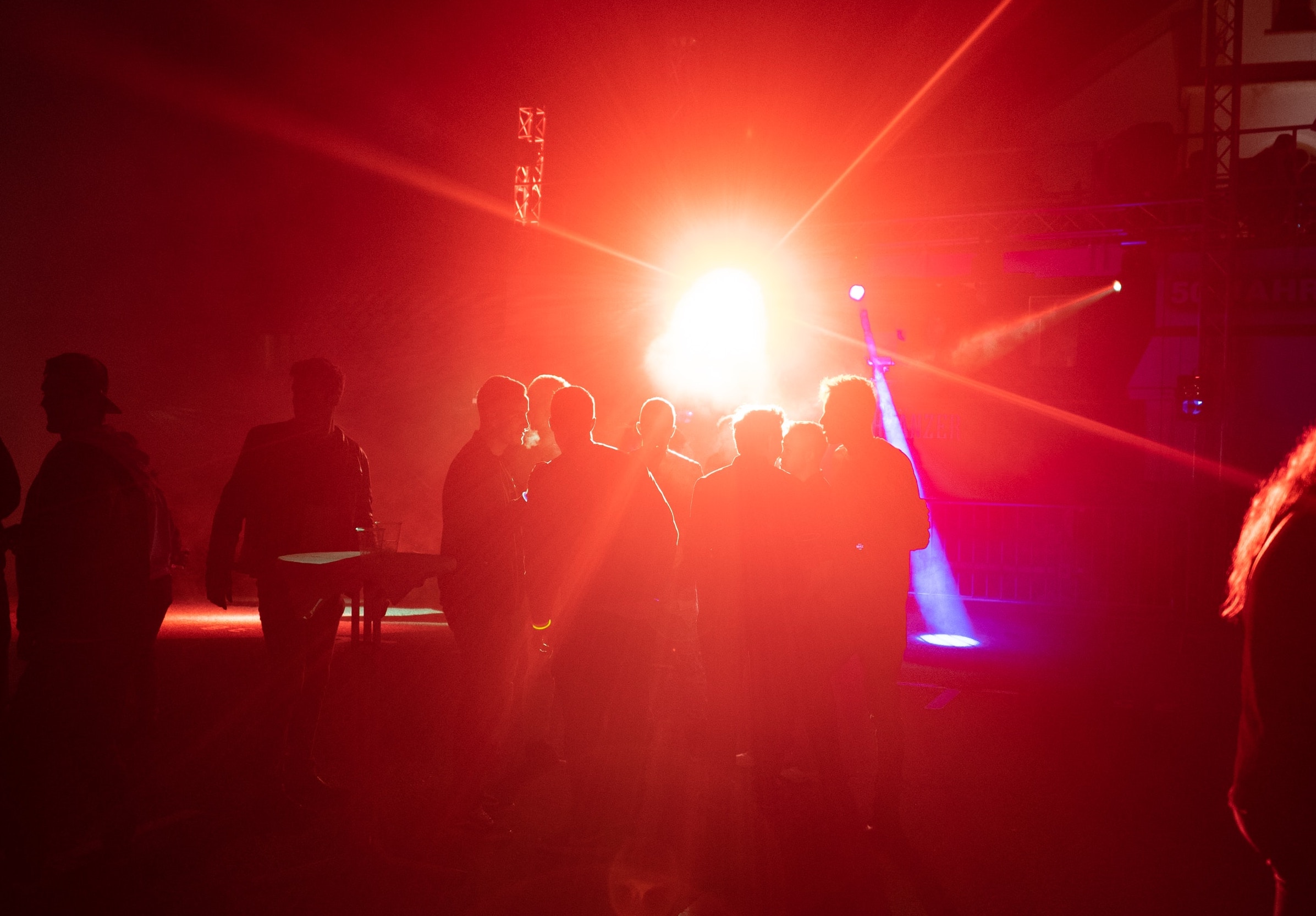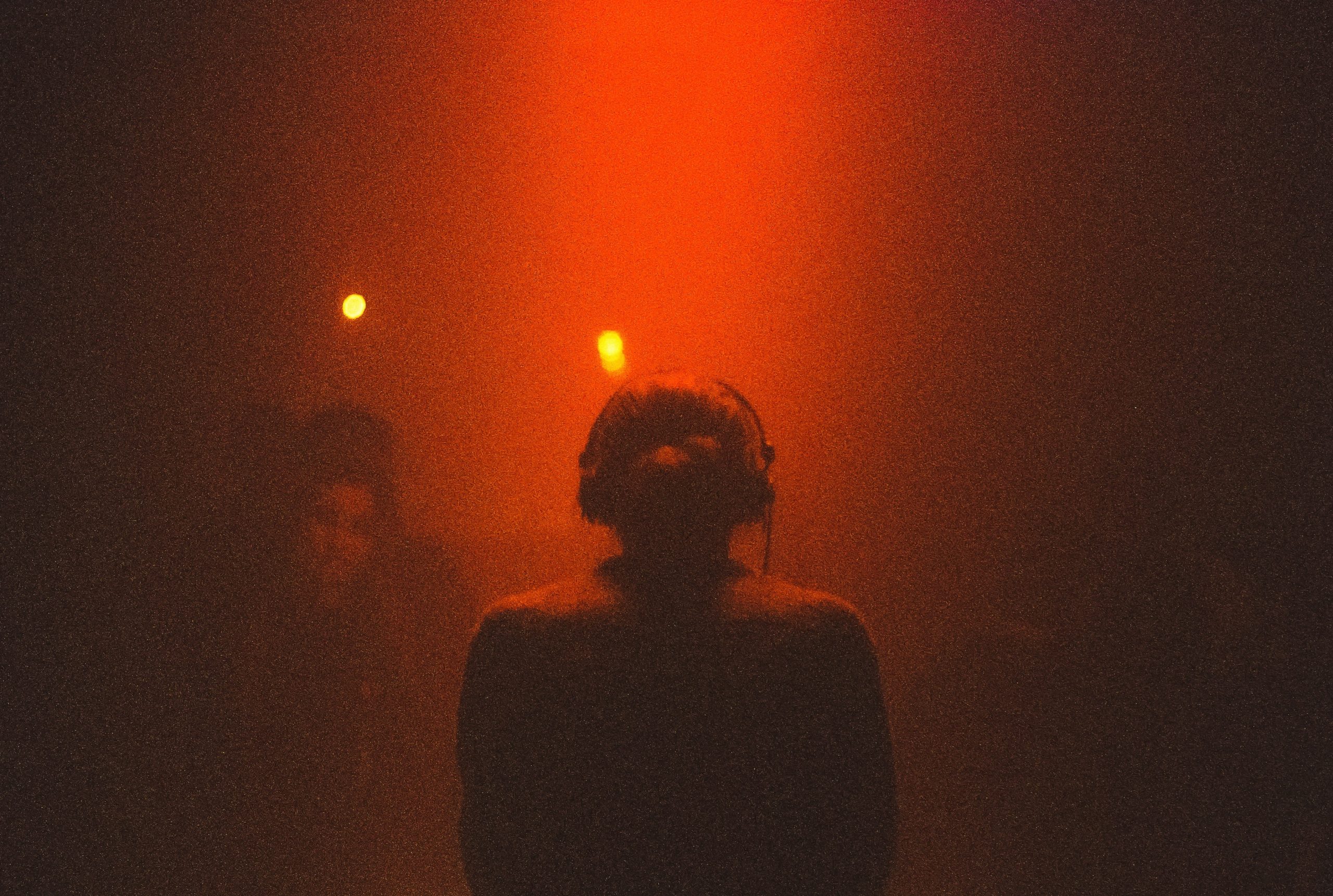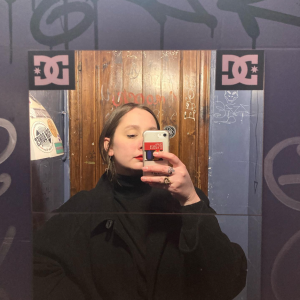MARTINA MACCIANTI: ART, SOUND, QUEERNESS (2/2)
ZUIHITSU
QUIRKY THOUGHTS COLLECTION
Essays, personal stories and curiosities from our guest fem人le contributors
MARTINA MACCIANTI: ART, SOUND, QUEERNESS (2/2)
A reflection on social transformation through art practice and listening
«By imposing rigid categories upon individuals, we deny the complexity of human subjectivity. We must dismantle the structures that confine us, liberating ourselves from the chains of binary thinking. Only then can we truly embrace the multitude of identities that exist within us.»
Paul B. Preciado

Voices/Exchanges
Art, in its diverse and plural expressions, is and has been a tool to explore and discover new worlds, to discuss dominant norms and values that often perpetuate inequality and exclusion. Enabling spaces for voices and expression, rewriting our perception of the world, creating new narratives and points of view. It can be used cross-culturally to reread past and present events under new perspectives. Be a medium for building a different society. Sound and listening, for example, can become a vehicle for exploring identity and politics.
At the core of these reflections is the needed rupture and fragmentation of the binarism that drives everything as we know it. Enabling a deeply queer understanding of what we see or hear, setting aside the pathological need to frame and propose a vertical, absolute, binary response to an action. At festivals with mostly male-composed programs, the answer cannot superficially be a slice of pink quotas to be included. The system to be challenged is broader and has deep roots. In this proposed trivial example, the point is this: here, now, the bug to be solved is not representatively a gender substitution to be implemented, but rather a personal and collective deconstruction of roles and enabling possibilities.
From Eshun’s and Goodman’s theories to Pauline Oliveros, highlighting the importance of intersectionality and technology in the creation of new sound spaces and reformulation of identities, emphasizing the centrality of gender issues and social margins, “ear power” becomes a tool for a deeper and more conscious exploration of the possibilities offered by sound and music, and for the construction of a more inclusive future.
Crossing then three crucial dimensions in this perspective: DIALOGUE, SHARING, FIGHT. In the context of struggle, a central theme in my personal research, I focus on the issue of anger, often seen as an emotion to be tamed, to be controlled. What if, instead of repressing it, we collectively decided to orchestrate it, to turn it into a powerful tool for change? From a repressed feeling to a symphony, a powerful and provocative work of art that resonates with tremendous force in those who hear it. This symphony of rage here represents an invitation to listen with a queer ear, with a sensitivity that goes beyond traditional dichotomies of gender and sexuality. It is a listening that does not merely acknowledge injustice, but that makes it properly felt, allows one to tune into anger and to understand its power and potential.
Transforming, then, anger into a desire, a passion for change. Becoming part of a collective body that desires and struggles for a possible world, of every body and non-body. An invitation to love and desire politically, an invitation to feel the struggle for equity not only as an ethical duty, but also as an erotic desire.
Arriving at a reflection on musical practice as a powerful tool to deeply understand what surrounds us and to investigate the social and political dynamics that influence our daily lives, using a political lens when we interact with the musical world.
The following exchanges aim to explore the relationship between art, sound, queerness and the political potential of artistic practice. By analyzing and contributing the words of three women who, in different ways and practices, have the capacity to explore identities through artistic expression, we aim to offer a stimulating perspective on artistic practice and its relationship to politics and society; an invitation to reflect on the nature of sound and artistic practice in general by considering their political and social potential, their capacity to create spaces of expression and listening for marginalized voices, to open to new perspectives, and create representation.
An infinite space. A ruin. Sound system resonating the most emotional music ever composed. Everyone is listening. Deeply. No division, no binarism. A dream in which to weep with joy, loud with love.

CLAUDIA ATTIMONELLI
Claudia Attimonelli is a researcher in Media Studies and Visual Culture, professor of Visual Studies and Digital Culture and Media, Visual Culture and Sound Studies at the University of Bari Aldo Moro; she is a lecturer in Visual and Multimedia Studies at the Master in Journalism Order of Journalists at the University of Bari. She is scientific head of the Gender Archive at the University of Bari; coordinator of the MEM – Mediateca Emeroteca Musicale project and directs the Dialogues on the Big – Bari International Gender Festival; she is visiting professor at Uerj University (Rio de Janeiro) and chercheuse associée at Université Paul-Valéry (Montpellier).
Her research on techno and Afrofuturism is considered seminal in the Italian and international scene; she is interested in issues of gender, urban styles and musical cultures.
As a curator she collaborates with theaters, institutions and galleries in the field of audio and visual languages; in 2023 she curated the international exhibition: 30 years of Kompakt: The visual side of Music.
Among her publications: Electronics is Women. Media, Bodies, and Transfeminist and Queer Practices (with C. Tomeo 2022); The Aesthetics of Malaise. The black, the skull, the punk (2020); A dark reflect. Black Mirror and the digital aurora (with V. Susca 2020, translated into 3 languages); Techno. Afrofuturist rhythms (2008-2018); Pornoculture (with V. Susca 2016, translated into 4 languages).
Martina: I want to talk to you about representation. When we talk about women, marginalized and/or racialized bodies, in music, and about the need to hear their voices, we often come up against a wall that hides behind the phrase “but music is music.” This implies for instance that if only male musicians, or white men, are going to be lined up at a festival, it will not be something negative, because music is music.
This is disconnected from any socio-political discourse and it can’t equate to boycott it (we often hear about pink quotas in politics or within labour policies). What is lost, in these forward hands, is the theme of representation: the importance of seeing on a stage someone who looks like you, who stimulates you toward expression, a voice coming from other places and shores. What do you think about that? Do you think you can build something really open and of all bodies by overcoming this wall?
Claudia: Representation and visibility are the criteria at the center of the discourse related to women and LGBTQIA+ people in relation to the places of greatest exposure, spectacularization and generation of figures capable of constituting models to be referred to by younger generations. That is, the people and bodies that have always found themselves at the margins of a knowledge that has been shaped for centuries around institutions which did not provide any form of access to women and Lgbtqia+ people; and that today find themselves in the condition of being able to renegotiate their presence, I believe, beyond the detestable pink quotas. The phrase you bring up, “but music is music,” requires a twofold reflection and in some ways produces a seemingly contradicting thought that I will attempt to illustrate: it is true that the gender quota system (better to call them that than pink quotas) as well as the European funding axes that have been calling for interventions aimed at closing or at least correcting the gender gap in the professional sphere for some time now, sometimes trigger counterproductive effects regarding the goals achieved through struggles on gender issues and specifically on the representation and presence of people normally excluded from festival billboards, from talks and panels (so-called manel, panels with only men), from musical events of various kinds.
These effects result from the necessity of having to adopt a system, which, in order to correct the centuries-old absence of women and Lgbtqia+ people from such venues, operates a quota forcing, i.e., quantitative, which does not always comply with the qualitative one. Hence an example: it may happen that, when finalising an electronic music festival line-up, there might be a request for the event to be closed by a DJ. This could be selected among the most popular and famous stars, or, should the financial means not allow for that, the DJ might be chosen by tackling the issue of gender quotas. In the latter case, the following problem would arise: being inexperienced in filling such an important role (the closing set of an intense night of sound and dance at 5am) might weigh on the performance of the DJ, who would be in the uncomfortable position of receiving criticisms due to the context. Moreover, this would support the thesis that women are less talented or not up to the task of filling certain roles, making the stereotype that the quota system would like to correct far worse.
And here is the contradiction that some of the essays in our volume seek to investigate and bring out: kept away for millennia – according to the history of Western culture – from the places of formation and exposure of expressive languages that have always been credited to the male, women and people on the margins of the patriarchal paradigm that we know well have needed many years, even decades, to finally find themselves in a condition of equality, in which the great gap that had separated them from their male colleagues will be much reduced, if not bridged. In this long intervening time, I personally believe that listening, patience and understanding must intervene, so that we do not immediately lash out against a female failure in contexts where women appear for the first time, especially since we have always been accustomed to dealing with a lot of male genius but also with inevitable mediocrity: how often do we find a performance, a talk, an event by only “male” artists boring, flawed, not up to the mark? It is natural for it to happen, if only for the inherent genius exceptionality. So it is not clear why excellence is always expected from women in top positions or when performing in unprecedented roles; mistakes, weaknesses and frailties are not admitted and flaws, errors and shortcomings always spotted by the most critical gaze.
It is very important to overcome the dilemma of gender quotas, to defuse the dangerous devices of competitiveness at all costs, of perfect performance vs. the possibility of imperfection, of the pursuit of genius vs. the affirmation of a condition in which the presence of women becomes normal, among whom some will emerge and others will fall into the norm. The aim of the volume edited by myself and Caterina Tomeo, thanks to the numerous interventions of the authors, is to propose a paradigm that does not focus on finding models from the past that are ingenious and therefore difficult to replicate in their uniqueness, but rather to follow the trail of technology to identify strategies and approaches through which people who have always been excluded from the technological factor are able to take other paths to operate, manipulate, recreate, recombine, detourn machines and tools.
Martina: Talking about art, sound and listening as a political act. One of the chapters that is particularly close to my heart and that I have most explored in the book edited by you and Caterina (Electronics is Women. Media, Bodies, Transfeminist and Queer Practices, Castelvecchi editore, 2022) is Daniela Gentile’s, Beyond Listening. Going beyond just listening (or just seeing, if we are talking about other artistic expressions), and trying to really experience what we find in front of us: by doing so, we can overcome bias, go beyond the addressed, colonial and patriarchal upbringing, which – in the West especially – indirectly defines us. The artistic space, its expression, if made fluid and open can be revolutionary. I personally believe that art, whether visual or musical, or any form of expression, can be powerful means of decolonizing and depatriarchalizing our gaze, even the most resistant ones. For you, what is the value and political power of artistic space?
Claudia: I like to think of art as not strictly political, but rather, to use an expression by Susca and De Kerckhove (2007), transpolitical, where the political would enslave art, making it a poor language with crushed purposes in the pursuit of a message, art instead remains an outpost of thought: the only free space/time and therefore in a great capacity to ask questions, to bring out contradictions, to activate conflicts and to challenge the dominant discourse. The practice of listening that you cite from Daniela Gentile’s essay is an example of this. Through listening itself we welcome the otherness of all the voices and sounds in which we are immersed or that come to us from afar through the media that spread them until they penetrate our ears. Some verses of a song, some samplings within a set remixed alongside each other when they reach our ears and penetrate inside, in fact begin to inhabit us and make us an expanded body, traversed by the sounds of Others, according to the concept of otherness and Others elaborated by the French philosopher Emmanuel Lévinas. Through listening, a powerful and viral form of hybridization is activated, a sonic contamination that infects us with the other(s), that makes them a sonic body to be shared, without there having to be inherent militant proclamations, because ‘mcluhanially’ the medium itself has become the bearer of political meaning through the wide dissemination and unstoppable accessibility of the other(s).
Pauline Oliveros in Quantum Listening (2005), speaks of “auricular power”, a power that allows marginalised people, those on the fringes and overflowing to resonate (Oliveros, Sounding the Margins – 2010), a potentiality that draws from the futurist avant-garde and in particular from The Art of Noises, the Manifesto of Luigi Russolo, who in 1913 spoke of the noises of the soundscape of the twentieth-century city compared to that of the countryside, imagining that they could be orchestrated and translated into sounds in sync with the times and the space being traversed. Such an unseen space is made up of bodies that signify it with their own identity.
Similarly in the practice of DJing and sampling, according to the theories of Kodwo Eshun, a Ghanaian-English author and Afrofuturism theorist, as well as in the words of Steve Goodman aka Kode9 in “Sonic Warfare. Sound affect and the ecology of fear” (Goodman, 2010), remixed sonic samples engage in a sonic battle, they spread, that is, what I call an intersectional sonic guerrilla warfare, through which minimal units of sound – the samples – whose provenance is beyond the binarism of genre, geographic-cultural provenance, age, and musical style are remixed, manipulated, and “effected.” The two key words, in fact, of a broad discourse around listening and gender issues, for me, are “intersectionality” and “technology,” where H is not an error but a glitch, a malfunctioning of the already given system of meaning, an augmented value that women reappropriate with purposes aimed at triggering processes of enchantment, ecstasy, rhythmic power, sensuality and corporeality of which dance is one of the effects.

Pic by Kajetan Sumila
DIANA LOLA POSANI
A voice and performance researcher, Deep Listening facilitator and independent curator, Diana Lola Posani is the founder of AKRIDA, a nomadic sound art festival that saw its first edition in Milan last year with artists such as Merlin Nova, Clara de Asís, Janneke Van Der Putten and Rie Nakajima and is now preparing for new stages. AKRIDA is a body festival based on an essential assumption: sound is the modification of space experienced with the body and gives space to artists who have a very close relationship with the organic, the material, with the textures of their instruments as well as those of the voice. Centering individualities that are free to self-define themselves with their own corporeality and practices, with an acute and personal vision, is part of Posani’s work, whose poetics sweeps across a broad horizon of philosophical and sensory inquiry through gesture and vocal experimentation.
Diana Lola Posani translated in Italian the book Deep Listening by Pauline Oliveros for Timeo.
Martina: We live in a society in which being deaf to other voices, to the depth of sounds, is imperative. How can we, today, re-learn and understand the power of listening that goes beyond, bringing this practice into our daily lives? Even and especially in the dynamics of sharing, dialogue and struggle, such as feminist conversation.
Lola: DIALOGUE. To begin to answer this question, I will borrow the definition “acoustic palimpsest” coined by Martin Daughtry. A palimpsest is a medieval manuscript that after being washed and rewritten continues to retain traces of the previous text, and Daughtry uses this metaphor to define a communication that includes what is apparently not there, meaning the unexplained but also, and more importantly, the silenced. It is often useful to ask: What are the acoustic specters of this conversation? The voices that do not have the space to speak? The forgotten stories, the unexpressed doubts? I believe that everything that is violently removed tends to resurface, as in the case of palimpsests. The process is slow but inevitable. There is often an unnecessary focus on making the invisible reappear, rather than on respecting it. Looking at a palimpsest the risk of overload in listening appears clearly. Being able to simultaneously embrace all the possible listening possibilities can become a trap made of paradoxes, an ongoing frustration related to our human limitation. The solution that Dylan Robinson proposes in Hungry Listening is that of oscillatory listening, that is, listening that does not attempt to move from one positionality to another, but rather oscillates in the relationship that unites the different layers. Perhaps through this kind of oscillatory listening one can really float between different singularities and open up to the deep nature of voice, which is a collective and shared nature. A simple one.
SHARING. When I talk about listening I do not mean the binary division between passive-listening and active-expression, a division I also associate with the female-male gender binarism. My mind frantically returns to the myth of Echo and Narcissus, to this radical division that becomes a curse for both. What does it mean to place oneself in active listening, and how does one express oneself receptively? It is certainly a complex and often painful inquiry.
Thinking about this, I am reminded of a performance by LYGIA CLARK, entitled BABA ANTROPOFÁGICA: “A man lying on the ground, helpless and with his eyes closed, is surrounded by a group of people who slowly unravel from his mouth a colored thread, resting on the man’s body. They start at the feet but soon the face is covered as well. At the end of the action, the wires are lifted and, having freed the man, a discussion ensues among the participants who, in turn, lie on the ground to suffer the same fate. (…) Clark gets the idea in a dream, where he sees a kind of ectoplasm leaking from his mouth: “I dreamed that I opened my mouth and pulled out a substance continuously. While this was happening I had the impression that I was losing my inner substance, a fact that distressed me greatly especially because I could not stop losing it.” (…)
As he admitted in a letter to Helio Oiticica dated July 6, 1974, the establishment of such a collective body was not painless and did not rest on any prior experience: “This exchange is not pleasant…. It is an exchange of psychic qualities and the word ‘communication’ is too weak to express what is happening within the group.”
I have no trouble imagining how painful this practice might have been. First because, as Lygia Clark comments, it could not stop emitting its substance, its essence. Likewise, no matter how much entering into a relationship may challenge us, hurt us or anger us, we cannot stop this process. We cannot surgically remove ourselves from the collective body we inhabit.
FIGHT. Vibration constitutes everything, intersects it, traverses it. Clearly it generates questions of a loving kind, which as such open wide chasms of possibility, creation and suffering. Concretely: how does one keep on listening despite anger? Audre Lorde speaks of a symphony of rage “I say symphony instead of cacophony because we had to learn how to orchestrate these furies so that they would not tear us apart.” Taking anger and orchestrating it, not taming it. Here, I envision this symphony of rage for a truly queer listening, one that can transform the awareness of injustice into an erotic permeability with the collective body.

Pic by Dima Kosh
LUISA SANTACESARIA
Luisa Santacesaria is a musician, musicologist and curator. A piano graduate who studied at the Fiesole School of Music, she graduated from the Department of Musicology and Cultural Heritage in Cremona (University of Pavia) with a thesis on the relationship between sound and space in electroacoustic music. In 2016 and 2017 she was music curator at the Luigi Pecci Center for Contemporary Art in Prato. She collaborates with the Amici della Musica of Florence, the University of Florence, the Centro Studi Luciano Berio and curates for Tempo Reale the experimental music review TRK. SOUND CLUB and the website musicaelettronica.it. He created with Valentina Bertolani the project Curating Diversity (curatingdiversity.org), which deals with the analysis of cultural and inclusion policies within the Italian music system. He is part of the Blutwurst collective and the Executors of Metal on Paper label 19’40”.
Martina: In a constantly rushing world, it seems that careful listening, going beyond the surface, is a mirage. However, I believe that practicing, for example, listening to artists outside our comfort zone, to voices that are often marginalized, can enable further reflection, and open up a broader understanding of reality. What do you think? What can we borrow from music practice, and art practice in general, to help us understand in depth what is around us?
Luisa: In your question there are several elements to consider. Let’s start with the personal choice of listening to a certain kind of music, as you write, of “artists outside our comfort zone, of voices that are often marginalized.” The notion that any work of art cannot be defined as “neutral” or “pure”, being a result of a number of elements, some related directly to the authors/artists (gender, ethnic background, age, economic conditions, social, geographic, and historical context in which he or she lives), others related to the space of enjoyment of the work (“who” we are and “where” we are when we come in contact with the work), has been expressed by many people. Choosing, therefore, to listen to certain artists and certain repertoires, can lead to the encounter and knowledge of worlds, ideas, and sensibilities that can certainly give us a richer understanding of today’s reality but also of the history that preceded us.
Another element of your question is the accessibility of certain listening. You talk about practicing listening, then about the ability of anyone to choose for themselves what to listen to in the myriad of offerings to which we have, more or less easily, access. Let’s consider, for example, that the material that we can listen to and that are most easily found on the Web or in the record catalogs of labels (and I am referring to works and autorə, of any musical genre and historical period-or that we see scheduled in the Italian and international concert system), are the result of a systemic selection based on fundamentally economic, social and political criteria. Therefore, choosing to listen to works by authors marginalized by this systematic selection can be called a political act in itself and it’s a way to create for these musics new spaces to live. If, however, we get on the side of those who choose for others, thus those who have a position of power in disseminating music (label curators, artistic directors, performers, etc.), based on what we decide to disseminate, publish, program we definitely can take a political stance.
In 2018, with musicologist Valentina Bertolani we created the project Curating Diversity (www.curatingdiversity.org), with the aim of analyzing the cultural and inclusion policies of the Italian music system. We set out to analyze on a quantitative level the ratio of male and female composers performed and male and females and soloists invited in the 2018/2019 concert seasons of symphonic and chamber music in Milan and Florence financed by public funds. In our analysis we have, very schematically (an approach with always problematic consequences), divided people into women/men and white/not white, with the intention of giving an intersectional reading of the situation. We then focused on seasons and festivals of contemporary and experimental music, conducting the same kind of quantitative analysis, to go and look at contexts where the new canon is being formed (thus, where it is helping to decide which composers will be most programmed and heard in the future). Along with the collection of quantitative data, we added that of qualitative data by conducting semi-structured interviews with some of the artistic directors and curators of the institutions and realities we had analyzed. In these interviews, we asked what the mission of the institution was, its cultural policy, how its internal organization functioned, and, at the end of the interview, we showed the artistic directors the data collected and the -horrifying- percentages, where the overwhelming majority of the attendance in the various programming was, amazingly, white men. All infographics of these analyses and our publications can be found at www.curatingdiversity.org.
You ask “what can we bring from music practice to help us understand in depth what is around us?” Choosing to listen to specific music or creating spaces for certain artists can have an impact, more or less, on the system. Using this political lens when we interact with the music world can be a way, if you will, to see its distortions and the discriminations it enacts, to read it from a different perspective and find a drive to create new spaces and change things.

Martina Maccianti, born in 1992, lives in Florence and writes about feminism moving through multiple and traverse lines. She is the founder of Fucina, an online space that focuses on topics such as sexuality, rights, equality, ecology, passing whenever possible through art and music. Martina sees in a feminism that is aware of the different and plural oppressions that can act, the only point of solution for a society that does not give the same space to every person, to everybody.
